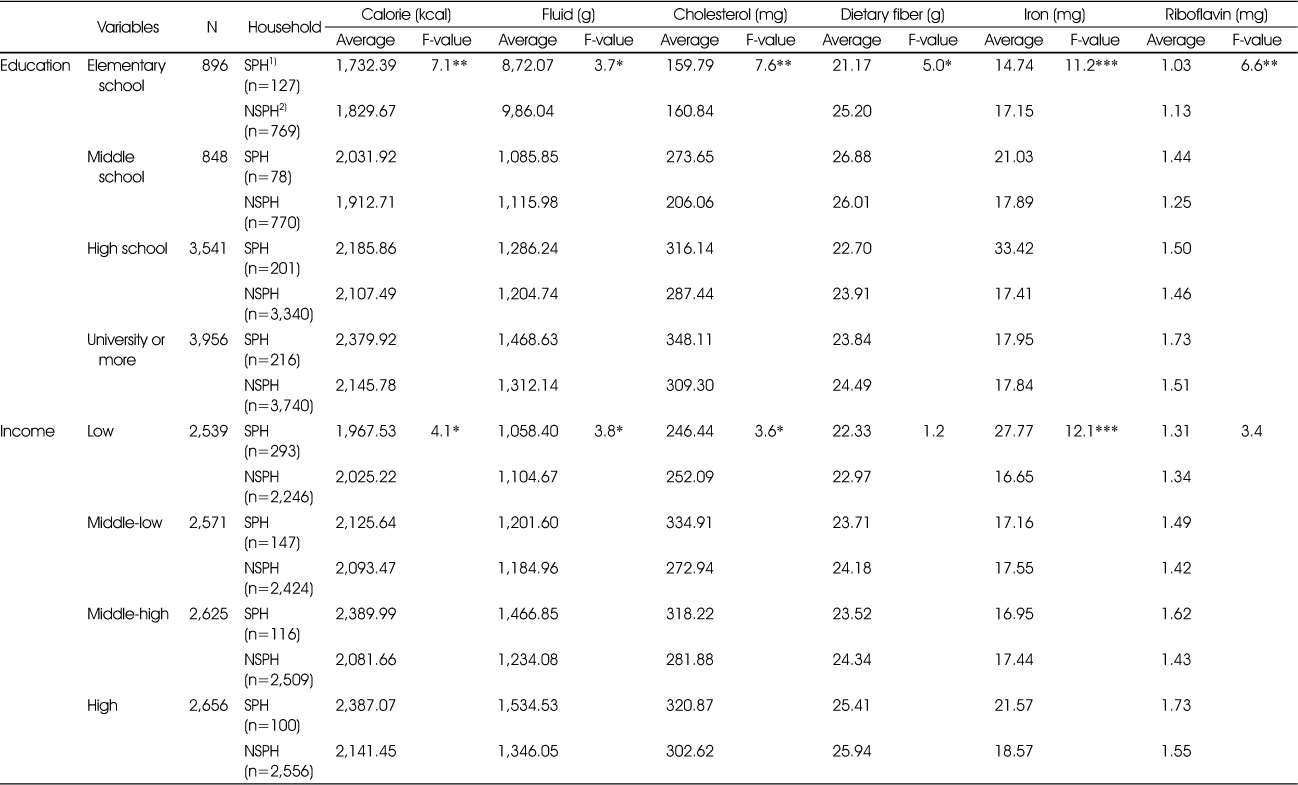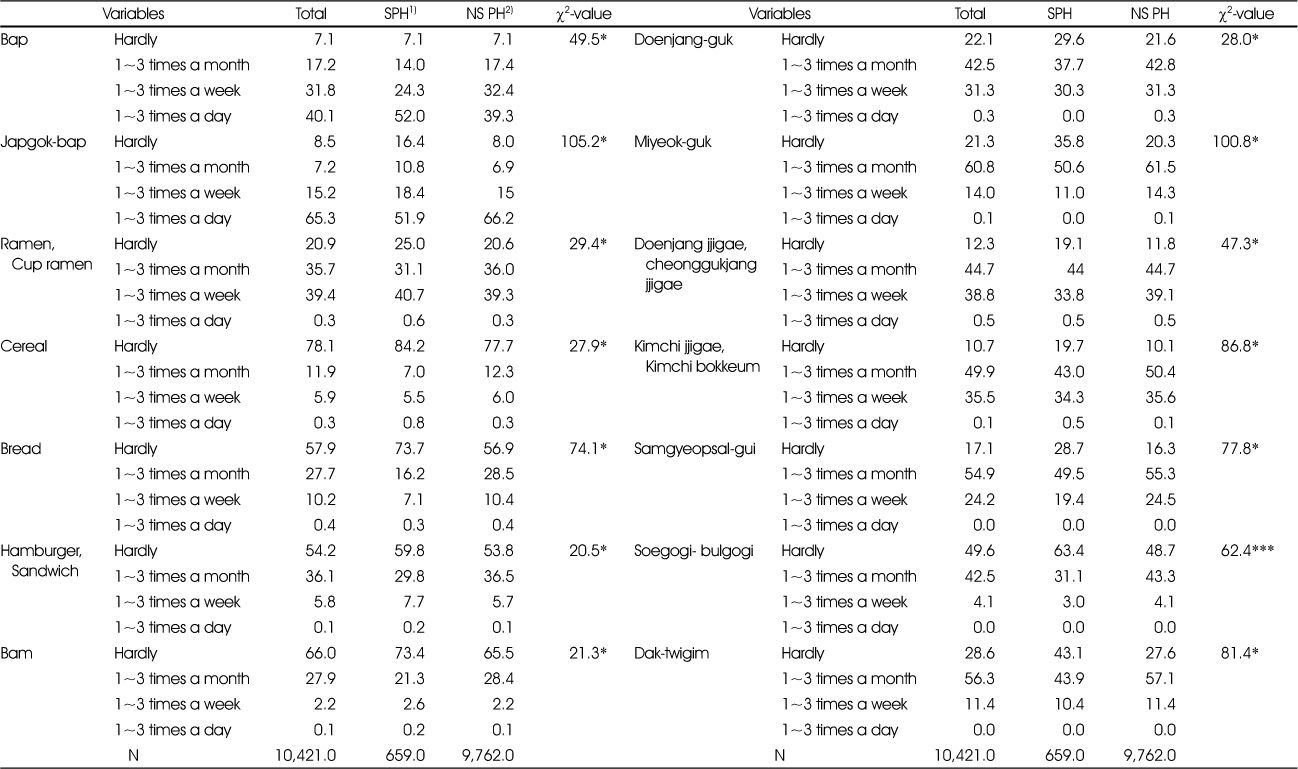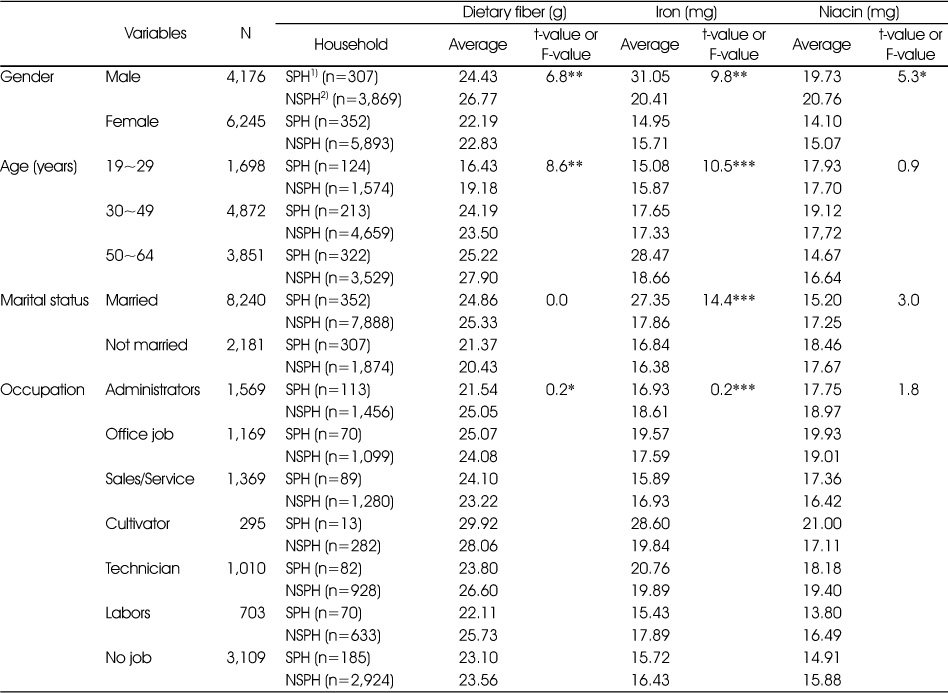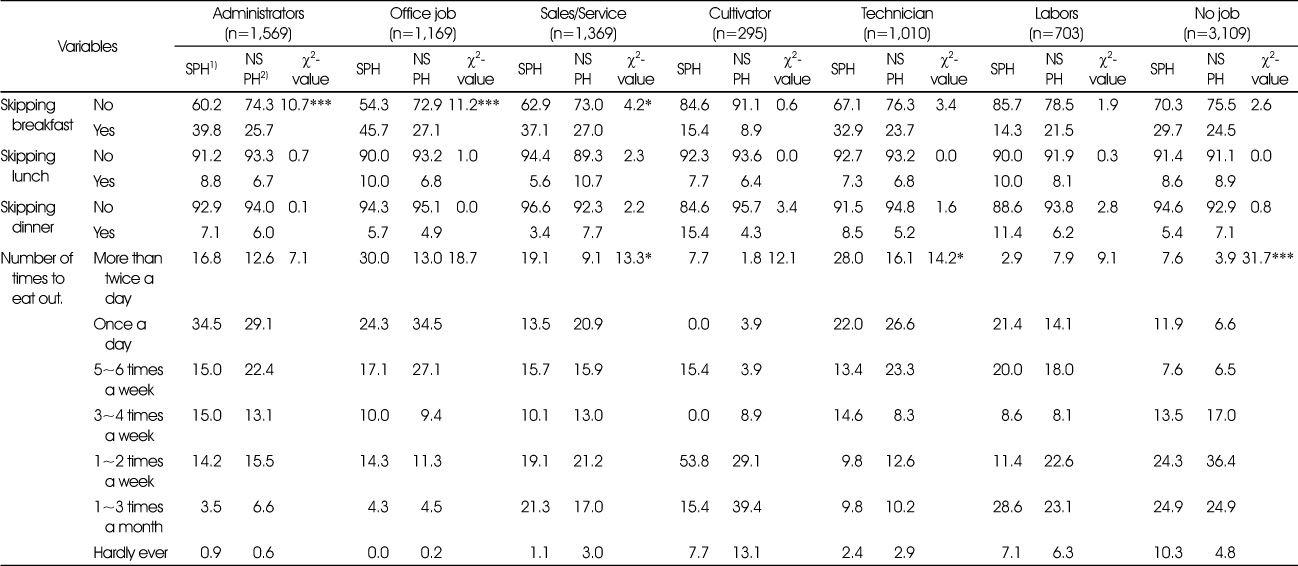Articles
- Page Path
- HOME > Korean J Community Nutr > Volume 24(1); 2019 > Article
-
Research Article
- Analysis of the Difference in Nutrients Intake, Dietary Behaviors and Food Intake Frequency of Single- and Non Single-Person Households: The Korea National Health and Nutrition Examination Survey (KNHANES), 2014–2016
-
Na-Yeon Kang, Bok-Mi Jung

-
Korean Journal of Community Nutrition 2019;24(1):1-17.
DOI: https://doi.org/10.5720/kjcn.2019.24.1.1
Published online: February 28, 2019
1Major in Nutrition Education, Graduate School of Education, Chonnam National University, Gwangju 61186, Korea, Student.
2Division of Food and Nutrition, Chonnam National University, Research Institute for Human Ecology, Gwangju 61186, Korea, Professor.
- Corresponding author: Bok-Mi Jung. Division of Food and Nutrition, Chonnam National University, 77, Yongbong-ro, Buk-gu, Gwangju 61186, Korea. Tel: (062) 530-1353, Fax: (062) 530-1339, jbm@jnu.ac.kr
Copyright © 2019 The Korean Society of Community Nutrition
This is an Open-Access article distributed under the terms of the Creative Commons Attribution Non-Commercial License (http://creativecommons.org/licenses/by-nc/3.0/) which permits unrestricted non-commercial use, distribution, and reproduction in any medium, provided the original work is properly cited.
- 2,184 Views
- 24 Download
- 28 Crossref
Abstract
-
Objectives
- This study was performed to compare the dietary life of single- and non single-person households in the Korea National Health and Nutrition Examination Survey (KNHANES).
-
Methods
- A nationally representative sample of 20,421 19-64-year-olds who had 24-hour recall data was taken from the 2014-2016 Korea National Health and Nutrition Examination Survey (KNHANES). Single- and non single-persons were compared for nutrient intake, dietary behaviors, food consumption patterns, nutrition education and confirm nutrition label.
-
Results
- The dietary intakes of dietary fiber and iron were lower in single-person households than in non single-person households. The lower the level of education and income, the lower the nutrient intake of single-person households. In the case of those aged 19 to 29, the breakfast skipping rate was higher in single-person households than in non single-person households. The higher the education level, the higher the breakfast skipping rate and the eating out frequency in the single-person households. In the food intake survey, the frequency of healthy food intake in single-person households was much lower than that of non single-person households. The confirmation rate of nutrition labeling was lower in single-person households than in non single-person households.
-
Conclusions
- This study shows that single-person households have poorer health-nutritional behaviors than multi-person households. Therefore, a nutrition education program based on the data of this study needs to be developed for health promotion of single-person households.
- 1. Statistics Korea. Population census [internet]. Statistics Korea; 2015; cited 2015 Apr 20]. Available from: http://kostat.go.kr/.
- 2. Kim HY. Floating families in Korea: Focusing on one-person households. J Soc Res 2014; 15(2): 255-292.
- 3. Korean Statistical Information Service. Population and household [internet]. KOSIS; 2018; cited 2018 Sep 1]. Available from: http://kosis.kr/visual/populationKorea/index/index.do?mb=N.
- 4. Kang ET, Kang JK, Ma KR. Subjective well-being of one-person households: focus on non-married and married one-person households. J Soc Sci 2016; 27(1): 3-23.Article
- 5. Gerrior SA, Guthrie JF, Fox JJ, Lutz SM, Keane TP, Basiotis PP. Differences in the dietary quality of adults living in single versus multiperson households. J Nutr Educ Behav 1995; 27(3): 113-119.Article
- 6. Daniels S, Glorieux I, Minnen J, van Tienoven TP, Weenas D. Convenience on the menu? A typological conceptualization of family food expenditures and food-related time patterns. Soc Sci Res 2015; 51: 205-218.ArticlePubMed
- 7. Daniels S, Glorieux I. Convenience, food and family lives. A socio- typological study of household food expenditures in 21st-century Belgium. Appetite 2015; 94: 54-61.ArticlePubMed
- 8. An HK. A study on the recognition and practice for reducing sodium intake of one-person households [Marster's thesis]. Chungang University; 2015.
- 9. Yue YA. The effect of food-related lifestyle on HMR product evaluations and satisfaction for single-person households: focused on convenience store private-brand products [Marster's thesis]. Sungkyunkwan University; 2015.
- 10. Lee KI, Hwang YJ, Ban HJ, Lim SJ, Jin HJ, Lee HS. Impact of the growth of single-person households on the food market and policy tasks. Korea Rural Economic Institute; 2015 10. Report No. 762.
- 11. Nam SY. Differences in dietary, nutritional and health status between single-person households and non-single person households in Korean adults by sex and age group [Marster's thesis]. Inha University; 2016.
- 12. Korean Society of Food and Technology. Dictionary of food & cookery science. Paju: Kyumoonsa; 2003. p. 424-441.
- 13. Serdula MK, Gillespie C, Kettel-Khan L, Farris R, Seymour J, Denny C. Trends in fruits and vegetable consumption among adults in the United States: Behavioral risk factor surveillance system, 1994-2000. Am J Public Health 2004; 94(6): 1014-1018.ArticlePubMedPMC
- 14. Kwon JH, Shim JE, Park MK, Paik HY. Evaluation of fruits and vegetables intake for prevention of chronic disease in Korean adults aged 30 years and over: Using the third Korea National Health and Nutrition Examination Survey (KNHANES III), 2005. Korean J Nutr 2009; 42(2): 146-157.Article
- 15. Paquette MC. Perceptions of healthy eating: state of knowledge and research gaps. Can J Public Health 2005; 96(Suppl 3): S15-S19.PubMed
- 16. Lee SH, Shim JS, Kim JY, Moon HA. The effect of breakfast regularity on eating habits, nutritional and health status in adults. Korean J Nutr 1996; 29(6): 533-546.
- 17. Min CY, Noh HY, Kang YS, Sim HJ, Baik HW, Song WO, et al. Skipping breakfast is associated with diet quality and metabolic syndrome risk factors of adults. Nutr Res Pract 2011; 5(5): 455-463.ArticlePubMedPMC
- 18. Yun S, Jeong HR, Kim MH. A survey on the breakfast skipping rate of Korean adults relative to their lifestyle and breakfast skipping reasons and dietary behavior of breakfast skippers. Korean J Community Nutr 2010; 15(2): 191-205.
- 19. Cho SH, Jang JH, Ha TY, Lee KS, Kim MK, Seo JS. A survey on breakfast of workers in Daegu area. Korean J Community Nutr 2004; 9(6): 673-682.
- 20. Lee SH, Kim JY, Moon HA. The effect of breakfast regularity on eating habits, nutritional and health status in adults. Korean J Nutr 1996; 29(5): 533-546.
- 21. Choi MK. An analysis of groups with diet problems associated with dining out. Korean J Food Nutr 2008; 21(4): 536-544.
- 22. Bes-Rastrollo M, Basterra-Gortari FJ, Sanchez-Villegas A, Marti A, Martinez JA, Martinez-Gonzalez MA. A prospective study of eating away-from-home meals and weight gain in a Mediterranean population: the SUN (Seguimiento Universidad de Navarra) cohort. Public Health Nutr 2010; 13(9): 1356-1363.ArticlePubMed
- 23. Kang YW, Hong KE, Choi HJ, Joung H. Dining-out behaviors of residents in Chuncheon city, Korea, in comparison to the Korean National Health and Nutrition Survey 2001. Nutr Res Pract 2007; 1(1): 57-64.ArticlePubMedPMC
- 24. Satia JA, Galanko JA, Siega-Riz AM. Eating at fast-food restaurants is associated with dietary intake, demographic, psychosocial and behavioral factors among African Americans in North Carolina. Public Health Nutr 2004; 7(8): 1089-1096.ArticlePubMed
- 25. Koo S, Park K. Dietary behaviors and lifestyle characteristics related to frequent eating out among Korean adults. J Korean Soc Food Sci Nutr 2013; 42(5): 705-712.Article
- 26. Kim MH, Kim H, Lee WK, Kim SJ, Yeon JY. Food habits and dietary behavior related to using processed food among male college students residing in dormitory and self-boarding in Gangwon. Korean J Community Nutr 2013; 18(4): 372-385.Article
- 27. Choi MK, Kim JM, Kim JG. A study on the dietary habit and health of office workers in Seoul. Korean J Food Cult 2003; 18(1): 45-55.
- 28. Lee YM, Cho WK, Oh YJ. Comparison of eating behavior between commensality and solo-eating of university students by BMI. Korean J Community Nutr 2012; 17(3): 280-289.Article
- 29. Tani Y, Kondo N, Takagi D, Saito M, Hikichi H, Ojima T, et al. Combined effects of eating alone and living alone on unhealthy dietary behaviors, obesity and underweight in older Japanese adults: Results of the JAGES. Appetite 2015; 95: 1-8.ArticlePubMed
- 30. Korea Health Industry Development Institute. National food & nutrition statistics I: based on 2014 Korea National Health and Nutrition Examination Survey. Cheongju: Korea Health Industry Development Institute; 2016. p. 9-60.
- 31. Chang CS, Eun JH. An analysis of chestnut purchase behavior by consumer characteristics. Korean J For Econ 2016; 23(2): 1-7.
- 32. Chung LN, Lee HY, Yang IS. Preference, satisfaction, and repurchase intention of consumers for home meal replacements (HMR) by product categories. Korean J Food Cookery Sci 2007; 23(3): 388-400.
- 33. Lee JY, Shin AS. Vegetable and fruit intake in one person household: The Korean National Health and Nutrition Examination Survey (2010~2012). J Nutr Health 2015; 48(3): 269-276.Article
- 34. Lee KI, Ban HJ, Heo SY, Park IH, Kim TH, Jin HJ. The consumer behavior survey for food: 2014 food consumption behavior survey basic analysis report. Korea Rural Economic Institute; 2014 12. E16-2014.
- 35. Choi MK. An analysis of groups with diet problems associated with dining out. Korean J Food Nutr 2008; 21(4): 536-544.
- 36. Lee SL, Lee SJ. The effects of eating habits and food consumption lifestyle on dietary life satisfaction of one-person households. J Consum Cult 2016; 19(3): 115-133.
- 37. Park JH, You SY. Analysis on food consumption behavior and dietary satisfaction according to household type. Korean J Agric Econ 2016; 57(2): 103-138.
- 38. Bae SJ. Comparison of health behaviors among single- and multiple- member households. Am J Health Behav 2007; 31(5): 514-525.ArticlePubMed
- 39. Heo YK, Sim KH. Dietary attitude of single households in metropolitan areas. Korean J Food Nutr 2016; 29(5): 735-745.Article
- 40. Chu SK, Kang NE, Yi SH. The effects of nutrition evaluation related to suitable food supply program for elders living alone in Sungnam city. Korean J Food Nutr 2007; 20(4): 467-475.
REFERENCES
Nutrients intake of a single person and non single person household by education and income level

Dietary behaviors of a single person and non single person household by gender, age and marital status

Dietary behaviors of a single person and non single person household by education and income level

Baps, starch food, guks, jjigaes and meat intake frequency of a single person and non single person household

Kimchi, side dish and fruit intake frequency of a single person and non single person household (1)

Figure & Data
REFERENCES
Citations

- Understanding the charactersitics and types of single-person households based on food purchase frequencies in Korea: a cross-sectional study using the 2023 Consumer Behavior Survey for Foods
So-Yun Kim, Youngmin Nam, Jong-Youn Rha, Haerang Lee
Korean Journal of Community Nutrition.2025; 30(1): 27. CrossRef - Dietary Behaviors and Health Status by Income Level in Single-Adult Households in Korea: An Analysis of Data From the 2016-2018 Korea National Health and Nutrition Examination Survey
Min-Hee Han, Bok-Mi Jung, Mi-Kyeong Choi
Clinical Nutrition Research.2025; 14(1): 55. CrossRef - Exploring the Impact of Cooking Fuel Choices on Household Food Security and Healthy Food Consumption in Indonesia
Moh Shadiqur Rahman, Sujarwoto Sujarwoto, Hery Toiba, Tri Wahyu Nugroho, Fahriyah Fahriyah, Mohammad Ilyas Shaleh, Tina Sri Purwanti, Bagus Andrianto
Review of Development Economics.2025; 29(4): 2242. CrossRef - A study on regional differences in dietary behaviors and satisfaction in Korea focusing on urban and rural comparisons: a cross-sectional study
Jong-Youn Rha, Sohyun Kim, Hae-Rang Lee, Juhyeon Kil
Korean Journal of Community Nutrition.2025; 30(2): 140. CrossRef - Generalized Anxiety Disorder Due to Household Type and Economic Status during COVID-19 Pandemic: Focusing on Gender Differences
Ye Eun Cha, Ju Yeong Hwang, Jin Young Nam
Journal of Health Informatics and Statistics.2024; 49(1): 89. CrossRef - Association of delivered food consumption with dietary behaviors and obesity among young adults in Jeju
Minjung Ko, Kyungho Ha
Journal of Nutrition and Health.2024; 57(3): 336. CrossRef - Comparison of Food and Nutrient Intake according to the Income Level in Korean Adult Single-Person Households: Using Data from the Korea National Health and Nutrition Examination Survey (2016-2018)
Min-Hee Han, Bok-Mi Jung
The Korean Journal of Community Living Science.2024; 35(3): 445. CrossRef - Diabetes Nutritional Management for Single-Person Households
Min Young Noh
The Journal of Korean Diabetes.2024; 25(4): 236. CrossRef - Analysis of intake trends of kimchi, fruits and vegetables (1998–2020) and factors associated with the intake (2016–2020): based on the Korea National Health and Nutrition Examination Survey
Jiwon Jeong, Jungmin Park, Yu Kyung Lee, Sung Wook Hong, Sangah Shin
Journal of Nutrition and Health.2023; 56(4): 404. CrossRef - The relationship between the prevalence of anemia and dietary intake among adults according to household types based on data from the 7th (2016–2018) Korea National Health and Nutrition Examination Survey
Hye Won Kim, Ji-Myung Kim
Journal of Nutrition and Health.2023; 56(5): 510. CrossRef - Analysis of Agrifood Consumer Competency and Dietary Satisfaction according to Household Type Using the Consumer Behavior Survey for Food
Meera Kim
Journal of the Korean Society of Food Science and Nutrition.2023; 52(4): 414. CrossRef - Comparison of Eating Habits and Behaviors of Young Single-Person Households based on Food-Related Lifestyle
Dokyung Kim, Sim-Yeol Lee
Korean Journal of Health Promotion.2023; 23(3): 117. CrossRef - Associations of cooking practices and healthy eating habits among young Korean adults in their 20s
So-Young Kim, Ji Yu Choi
International Journal of Gastronomy and Food Science.2023; 31: 100644. CrossRef - Perception to the dietary guidelines for Koreans among Korean adults based on sociodemographic characteristics and lifestyle
Yejin Yoon, Soo Hyun Kim, Hyojee Joung, Seoeun Ahn
Journal of Nutrition and Health.2023; 56(6): 742. CrossRef - Comparison of Health Behaviors between Adults with Hypertension in Single- and Multi-Person Households: Based on the 8th Korea National Health and Nutrition Examination Survey
Yongjae Yu, Youn Huh, Sung Sunwoo
Korean Journal of Health Promotion.2023; 23(1): 1. CrossRef - Association between Healthy Eating Index and Mental Health in Middle-Aged Adults Based on Household Size in Korea
Ji-Myung Kim, EunJung Lee
International Journal of Environmental Research and Public Health.2022; 19(8): 4692. CrossRef - A Qualitative Study of the Awareness and Influencing Factors of the Dietary Habits of the Male and Female Workers' at a Manufacturing Facility in Gwangju
Ji Suk Yim, Young-Ran Heo
Korean Journal of Community Nutrition.2022; 27(1): 12. CrossRef - Association between eating alone and cardiovascular diseases in elderly women: a cross-sectional study of KNHANES 2016 data
Han-Gyo Choi, Hye-Jin Kim, Seok-Jung Kang
Menopause.2022; 29(1): 82. CrossRef - An analysis of customer needs for the operation of unmanned food stores on a university campus
Se-Eun Kim, Min-Seo Park, Hyun-Joo Bae
Journal of Nutrition and Health.2022; 55(5): 587. CrossRef - Comparison of Dietary Behaviors and the Prevalence of Metabolic Syndrome in Single- and Multi-Person Households among Korean Adults
Kyung Won Lee, Dayeon Shin
Healthcare.2021; 9(9): 1116. CrossRef - Nutritional status and metabolic syndrome risk according to the dietary pattern of adult single-person household, based on the Korea National Health and Nutrition Examination Survey
Yu Been Keum, Qi Ming Yu, Jung-Sook Seo
Journal of Nutrition and Health.2021; 54(1): 23. CrossRef - Relationship between Eating Behavior and Healthy Eating Competency of Single-Person and Multi-Person Households by Age Group
Seung-Hee Hong, Ji-Myung Kim
Korean Journal of Community Nutrition.2021; 26(5): 337. CrossRef - Current Trends in Nursing Research Across Five Locations: The United States, South Korea, Taiwan, Japan, and Hong Kong
Eun‐Ok Im, Reiko Sakashita, Chia‐Chin Lin, Tae‐Hwa Lee, Hsiu‐Min Tsai, Jillian Inouye
Journal of Nursing Scholarship.2020; 52(6): 671. CrossRef - Short-term Cudrania tricuspidata fruit vinegar administration attenuates obesity in high-fat diet-fed mice by improving fat accumulation and metabolic parameters
Jun-Hui Choi, Myung-Kon Kim, Soo-Hwan Yeo, Seung Kim
Scientific Reports.2020;[Epub] CrossRef - Healthy Eating Capability of One-person Households-The Effects of Eating Alone, Meal Types, and Dietary Lifestyles
Seonglim Lee, Ilsook Choi, Junghoon Kim
Family and Environment Research.2020; 58(4): 483. CrossRef - Comparison of Dietary Behavior of Eating Alone in Single Households by Status of Workers and Age
Pil Kyoo Jo, Yu Jin Oh
Korean Journal of Community Nutrition.2019; 24(5): 408. CrossRef - Home Meal Replacement Use and Eating Habits of Adults in One-Person Households
Mi-Kyeong Choi, Eun-Sun Park, Mi-Hyun Kim
Korean Journal of Community Nutrition.2019; 24(6): 476. CrossRef - Evaluation of the Nutrition Status and Metabolic Syndrome Prevalence of the Members according to the Number of Household Members based on the Korea National Health and Nutrition Examination Survey (2013–2014)
Jin-Young Lee, Soo-Kyong Choi, Jung-Sook Seo
Korean Journal of Community Nutrition.2019; 24(3): 232. CrossRef
General characteristics of the subjects N (%)
1) SPH=single person household, 2) NSPH=non single person household
Nutrients intake of the households by gender, age, marital status and occupation
1) SPH=single person household, 2) NSPH=non single person household
*: p<0.05, **: p<0.01, ***: p<0.001
Nutrients intake of a single person and non single person household by education and income level
1) SPH=single person household
2) NSPH=non single person household
*: p<0.05, **: p<0.01, ***: p<0.001
Dietary behaviors of a single person and non single person household by gender, age and marital status
1) SPH=single person household
2) NSPH=non single person household
*: p<0.05, **: p<0.01, ***: p<0.001
Dietary behaviors of a single person and non single person household by education and income level
1) SPH=single person household
2) NSPH=non single person household
**: p<0.01, ***: p<0.001
Dietary behaviors of a single person and non single person household by occupation
1) SPH=single person household
2) NSPH=non single person household
*: p<0.05, ***: p<0.001
Baps, starch food, guks, jjigaes and meat intake frequency of a single person and non single person household
1) SPH=single person household
2) NSPH=non single person household
*: p<0.05, ***: p<0.001
Kimchi, side dish and fruit intake frequency of a single person and non single person household (1)
1) SPH=single person household
2) NSPH=non single person household
***: p<0.001
Snacks and drinks intake frequency of a single person and non single person household
1) SPH=single person household
2) NSPH=non single person household
*: p<0.05, **: p<0.01, ***: p<0.001
Nutrition education and confirm nutrition label of households by gender, age, education, income, marital status and occupation
1) SPH=single person household
2) NSPH=non single person household
*: p<0.05, ***: p<0.001
1) SPH=single person household, 2) NSPH=non single person household
1) SPH=single person household, 2) NSPH=non single person household *:
1) SPH=single person household 2) NSPH=non single person household *:
1) SPH=single person household 2) NSPH=non single person household *:
1) SPH=single person household 2) NSPH=non single person household **:
1) SPH=single person household 2) NSPH=non single person household *:
1) SPH=single person household 2) NSPH=non single person household *:
1) SPH=single person household 2) NSPH=non single person household ***:
1) SPH=single person household 2) NSPH=non single person household *:
1) SPH=single person household 2) NSPH=non single person household *:

 KSCN
KSCN





 Cite
Cite


